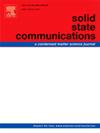Understanding and calculating the effects of uniaxial and hydrostatic pressure on the critical temperature of YBa2Cu3O7-δ (Y-123) superconductor within the framework of the Casimir energy scenario and the Kempf equation
IF 2.4
4区 物理与天体物理
Q3 PHYSICS, CONDENSED MATTER
引用次数: 0
Abstract
Hydrostatic and uniaxial pressure affect the critical temperature of superconductivity differently in high-temperature superconductor samples, which is still not fully understood. In this paper, we investigate the changes in the critical temperature of the optimally doped (Y-123) superconductor under hydrostatic and uniaxial pressure, and we analyze the reasons for the unusual uniaxial pressure effects on the critical temperature in this compound compared to other cuprate superconductors. Our analysis is based on the Casimir energy scenario approach. In this context, we utilize the uniaxial pressure derivatives of the critical temperature, , derived from the Kempf equation. Our results indicate that pressure applied along different crystallographic axes alters the charge carrier density and effective mass within the CuO2 planes of the Y-123 superconductor differently. These changes, in turn, affect the sign and magnitude of as predicted by our derived equations.
在Casimir能量情景和Kempf方程的框架下,理解和计算单轴和静水压力对YBa2Cu3O7-δ (Y-123)超导体临界温度的影响
在高温超导体样品中,静水压力和单轴压力对超导临界温度的影响是不同的,这一点目前还不完全清楚。本文研究了最佳掺杂YBa2Cu3O7−δ (Y-123)超导体在静水压力和单轴压力下的临界温度变化,并分析了与其他铜超导体相比,该化合物的临界温度受到单轴压力影响的原因。我们的分析是基于卡西米尔能源情景方法。在这种情况下,我们利用了临界温度的单轴压力导数,dTc/dPi(i=a,b,c),由Kempf方程导出。结果表明,沿不同晶轴施加的压力不同程度地改变了Y-123超导体CuO2平面内的载流子密度和有效质量。这些变化反过来又影响我们推导的方程所预测的dTc/dPi的符号和大小。
本文章由计算机程序翻译,如有差异,请以英文原文为准。
求助全文
约1分钟内获得全文
求助全文
来源期刊

Solid State Communications
物理-物理:凝聚态物理
CiteScore
3.40
自引率
4.80%
发文量
287
审稿时长
51 days
期刊介绍:
Solid State Communications is an international medium for the publication of short communications and original research articles on significant developments in condensed matter science, giving scientists immediate access to important, recently completed work. The journal publishes original experimental and theoretical research on the physical and chemical properties of solids and other condensed systems and also on their preparation. The submission of manuscripts reporting research on the basic physics of materials science and devices, as well as of state-of-the-art microstructures and nanostructures, is encouraged.
A coherent quantitative treatment emphasizing new physics is expected rather than a simple accumulation of experimental data. Consistent with these aims, the short communications should be kept concise and short, usually not longer than six printed pages. The number of figures and tables should also be kept to a minimum. Solid State Communications now also welcomes original research articles without length restrictions.
The Fast-Track section of Solid State Communications is the venue for very rapid publication of short communications on significant developments in condensed matter science. The goal is to offer the broad condensed matter community quick and immediate access to publish recently completed papers in research areas that are rapidly evolving and in which there are developments with great potential impact.
 求助内容:
求助内容: 应助结果提醒方式:
应助结果提醒方式:


